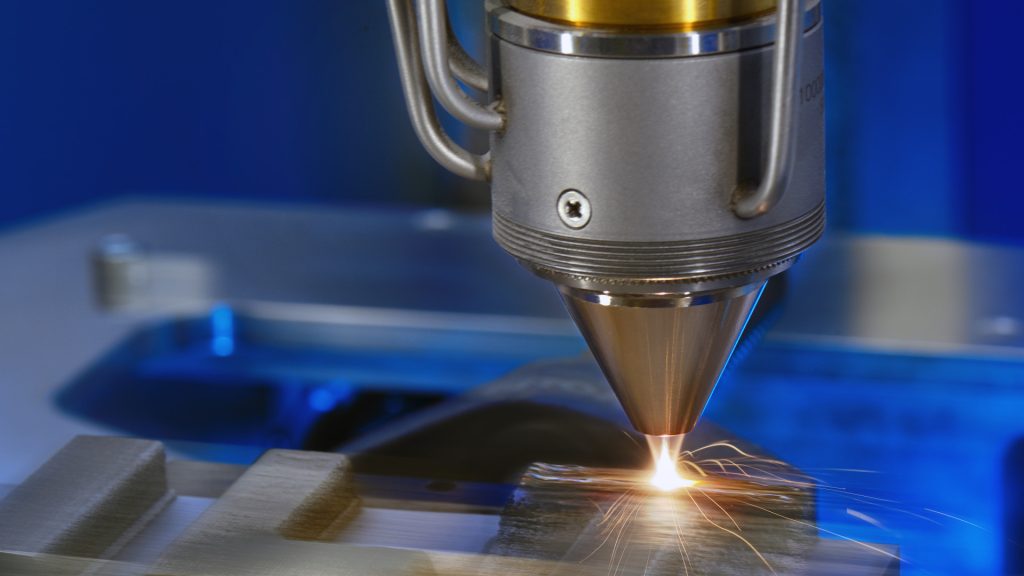The Fraunhofer Institute for Laser Technology (ILT) and Germany-based engineering firm Ponticon are conducting a new set of research projects using the latest version of ILT’s patented Extreme High-Speed Laser Material Deposition (EHLA) 3D printing technology.
Originally developed in 2017, EHLA is ILT’s take on high-volume directed energy deposition, or DED. It was initially offered as a modular toolhead that could be integrated into gantries and robotic arms, handling both the material deposition and melting actions simultaneously.
Since its release in 2017, the partners have been working on a next-generation version of the technology better suited to additive manufacturing applications and completed the first prototype in 2019. Simply dubbed ‘EHLA 3D’, the upgrade offers higher build rates, greater flexibility and material diversity, and higher precision.
“In order to make the advantages of EHLA 3D available to a large group of users in the industrial environment, Fraunhofer ILT is currently conducting targeted research work,” says Jonathan Schaible, research associate at Fraunhofer ILT. “There is still a lot of experimental and empirical preliminary work to be done. However, the first interested parties from industry have already put out their feelers. So we know we are on the right track.”

Extreme High-Speed Laser Material Deposition
Metal parts used for industrial applications in sectors such as aerospace, energy, and automotive tend to be exposed to extreme conditions. As a result, engineers employ the use of special coatings to protect these parts from corrosion and wear. According to ILT, however, conventional cladding processes such as hard chrome plating are struggling to meet increasingly stringent performance standards due to a lack of flexibility, resource efficiency, and costs.
Fraunhofer ILT describes its EHLA technology as a more efficient and environmentally-friendly alternative to conventional cladding processes. The process delivers feed rates of up to 500 meters per minute, which can be up to 250 times faster than other laser material deposition technologies. It can also apply significantly thinner layers at just 25 microns, while achieving smoother part surfaces.
”In principle, EHLA is suitable for everything that is rotationally symmetrical and can be machined on a fast rotary kinematic system,” adds Schaible. “The only question is why we should limit ourselves to simple round parts when a much wider range of possible applications is conceivable?”
Taking EHLA to the third dimension
The next-generation EHLA 3D process is geared more towards hardcore 3D printing but still has its uses as a cladding technique. Rather than being designed for integration with a robotic arm, the system is based on the kinematics of a tripod, whereby three linear motors are connected to a build platform on which the 3D printed part is processed. This structure enables the platform to make rapid, precise movements without generating any major vibrations.
Currently, EHLA 3D can process parts weighing up to 25kg, at speeds of around 200 meters per minute, with a very high precision of 100 microns. Fraunhofer ILT intends to pour more research into process monitoring concepts, automated path planning tools, and build parameter refinement.
Several companies from the aerospace and turbomachinery sectors are also currently in the process of refining EHLA 3D, as part of a project under the International Center for Turbomachinery Manufacturing (ICTM). A follow-up project is expected to commence in 2022, with further bilateral and publicly-funded consortium projects also in the works.
”In the near future, the technology should enable us to produce even complex, filigree structures easily and cost-effectively on a large scale,” says Schaible. “Individualized components are also conceivable.”

EHLA isn’t the only additive manufacturing process to be developed by one of Fraunhofer’s institutes. Researchers from the Fraunhofer Institute of Production Technology (IPT) have also developed a novel 3D printing process specifically for the production of rotational power transmitters such as drive shafts. Named Express Wire Coil Cladding (EW2C), the method is intended as a more material-efficient alternative to the commonly used subtractive turning process.
Elsewhere, at the Fraunhofer Institute for Ceramic Technologies and Systems (IKTS), researchers developed a Multi Material Jetting (MMJ) system designed to combine multiple materials into a single 3D printed part. The machine is largely based on binder jetting technology, and is compatible with both metals and ceramics.
Subscribe to the 3D Printing Industry newsletter for the latest news in additive manufacturing. You can also stay connected by following us on Twitter, liking us on Facebook, and tuning into the 3D Printing Industry YouTube Channel.
Looking for a career in additive manufacturing? Visit 3D Printing Jobs for a selection of roles in the industry.
Featured image shows the 3D printing of Fraunhofer ILT lettering as a demonstrator component for the new, highly productive EHLA 3D process. Photo via Fraunhofer ILT.



